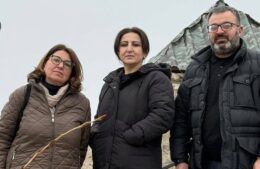Garegin Nzhdeh’s Statue to be Erected in Bulgaria
- (0)

PLISKA, Bulgaria (Armenian Weekly)—A statue of revered Armenian statesman and military strategist Garegin Nzhdeh (also spelled Karekin Nejdeh and Njdeh) will be erected in Pliska’s Cyrillic Courtyard.
“There will be more than 80 monuments of prominent figures of different nations and countries. The Armenian people will be represented by the statue of the well-known figure and philosopher Garegin Nzhdeh ,” Karen Alexanyan, the Bulgarian-Armenian founder of the Cyrillic Courtyard told Russian-Armenian news outlet Rusarminfo.
Though the Cyrillic Courtyard, which opened in 2015, is dedicated to the Cyrillic alphabet, there are several pieces of art dedicated to different nationalities and people. One of the pieces is an Armenian khatchkar (cross-stone), which was a gift from the Armenian community to the Bulgarian people on the occasion of the 1150th anniversary of Bulgaria’s adoption of Christianity.
Alexanyan noted that he has recently visited Armenia for consultations with various sculptors and artists. He also explained that Nzhdeh’s monument will likely be opened by the summer.
Below is Nzhdeh’s biography from Hairenik Press’ Voices from the Past: Excerpts from the Writings of Armenian Revolutionaries, edited and translated by former Armenian Weekly Editor Vahe Habeshian.
***
Nzhdeh was born in the village of Kznout, in Nakhijevan, the youngest of four children. His father was the village priest. Nzhdeh received his early education at a Russian school in the city of Nakhijevan. He continued his education at the Tiflis Russian Gymnasium (high school), then attended St. Petersburg University. After two years of study at the Faculty of Law there, he returned to the Caucasus to join the Armenian national liberation movement against the Russian and the Ottoman Empires.
In 1906, the Armenian Revolutionary Federation (ARF) sent Nzhdeh to Bulgaria to attend military school. He graduated from the Sofia military academy in 1907. In 1908, he participated in the Iranian constitutional revolution alongside Rostom, Yeprem Khan, Mourad of Sepasdia, and other Armenian revolutionaries.
In 1909, Nzhdeh was arrested in the Caucasus by the Russian authorities and spent three years in prison but eventually managed to escape. In 1912, he joined Andranik’s Armenian battalion within the Macedonian-Adrianopolitan Volunteer Corps of the Bulgarian Army and fought against the Ottoman Empire in the Balkan wars, during which he was wounded.
Nzhdeh returned to the Caucasus in 1914–1915 to help in the formation of the Armenian volunteer regiments within the Russian army to fight against the Ottoman Empire. He was second in command to Dro, who commanded the Second Armenian Regiment. In 1916, Nzhdeh commanded a special Armenian-Yezidi military unit.
Nzhdeh played a key role in organizing the troops for the defense of Gharakilise in May 1918. After the declaration of the independent First Republic of Armenia, Nzhdeh was appointed governor of Nakhijevan. In August 1919, he was appointed commander of the Southern Corps of the Armenian army.
Following the Sovietization of Armenia in December 1920, the Bolsheviks proposed that Karabagh and Zangezour be granted to Soviet Azerbaijan. Nzhdeh , who vehemently opposed the idea, led the defense of Siunik region against the rising Bolshevik movement and declared Siunik’s autonomy.
After the February 1921 revolt against Soviet rule in Yerevan, the ARF controlled Yerevan and surrounding regions for some 42 days before being overwhelmed by numerically superior Red Army troops in April. The leaders of the rebellion then retreated into the Siunik region.
In April 1921, the independence of the self-governing region of Zangezour and surrounding areas was declared the Republic of Mountainous Armenia (Lernahayastani Hanrapetoutiun). Nzhdeh was proclaimed its prime minister and minister of defense.
After months of fierce battles with the Red Army, the Republic of Mountainous Armenia capitulated in July 1921, following Soviet Russia’s promises to keep the mountainous region a part of Armenia. Nzhdeh , his soldiers, and Armenian intellectuals, including leaders of the first Independent Republic of Armenia, crossed the Arax River into neighboring Iran. Soon thereafter, Nzhdeh returned to Sofia, Bulgaria, where he married a local Armenian woman and started a family.
Nzhdeh was involved in organizing the Armenian communities of Bulgaria, Romania, and the United States. In 1933, by decision of the ARF, Nzhdeh moved to the U.S. to organize the youth. Assisted by Kopernik Tandourjian, Nzhdeh founded the Tzeghagron movement, which soon became the Armenian Youth Federation (AYF, the ARF’s youth organization.)
In 1937, he returned to Bulgaria, where he published the Razmik Armenian newspaper and, along with a group of Armenian intellectuals in Sofia, founded the Taron Nationalist Movement and published its organ, the Taroni Artziv paper. He maintained close contacts with Macedonian Bulgarian revolutionary organizations.
During the Second World War, Nzhdeh attempted to gain the support of the Axis Powers (namely, Germany) as well as the Allied Powers (specifically, the Soviet Union) by proposing Armenian assistance in return for attacking Turkey. Convinced to travel to Moscow for talks, he was arrested and held in Lubyanka prison.
In Nov. 1946, Nzhdeh was sent to Yerevan for trial, and on April 24, 1948, he was sentenced to 25 years’ imprisonment. Between 1948 and 1952, Nzhdeh was kept in the Vladimir prison for dangerous criminals, in Vladimir, Russia, about 100 miles northeast of Moscow. He was then transferred to Yerevan and kept in a secret prison there until the summer of 1953, and was subsequently returned to Vladimir.
According to fellow prisoner Hovhannes Devejian, Nzhdeh’s transfer to Yerevan was related to an attempt to mediate between the ARF and the Soviet leadership. After long negotiations with the security services of Soviet Armenia, Nzhdeh and Devejian prepared a letter in Yerevan prison (1953) addressed to ARF leader Simon Vratsian, calling for co-operation with the Soviets regarding the issue of the Armenian struggle against Turkey. However, the Communist Party leadership in Moscow rejected the undertaking.
Receiving a telegram from the Soviet authorities announcing Nzhdeh’s death in 1955, his brother, Levon Ter Haroutiunian, left Yerevan for Vladimir. He received Nzhdeh’s watch and clothing but was not allowed to take Nzhdeh’s writings. The authorities also did not allow the transfer of Nzhdeh’s body to Armenia. Nzhdeh was buried in Vladimir.
On Aug. 31, 1983, his remains were secretly transferred from Vladimir to Soviet Armenia as a result of the direct efforts of Pavel Ananian, the husband of Nzhdeh’s granddaughter, with the help of Varag Arakelian, Gourgen Armaghanian, Garegin Mkhitarian, Artsakh Buniatian, and Zhora Barseghian.
On April 26, 2005, during the celebration of the 84th anniversary of the Republic of Mountainous Armenia, parts of Nzhdeh’s remains were reburied on the slopes of Mount Khoustoup, near Kapan, in Siunik, per Nzhdeh’s wishes.


















